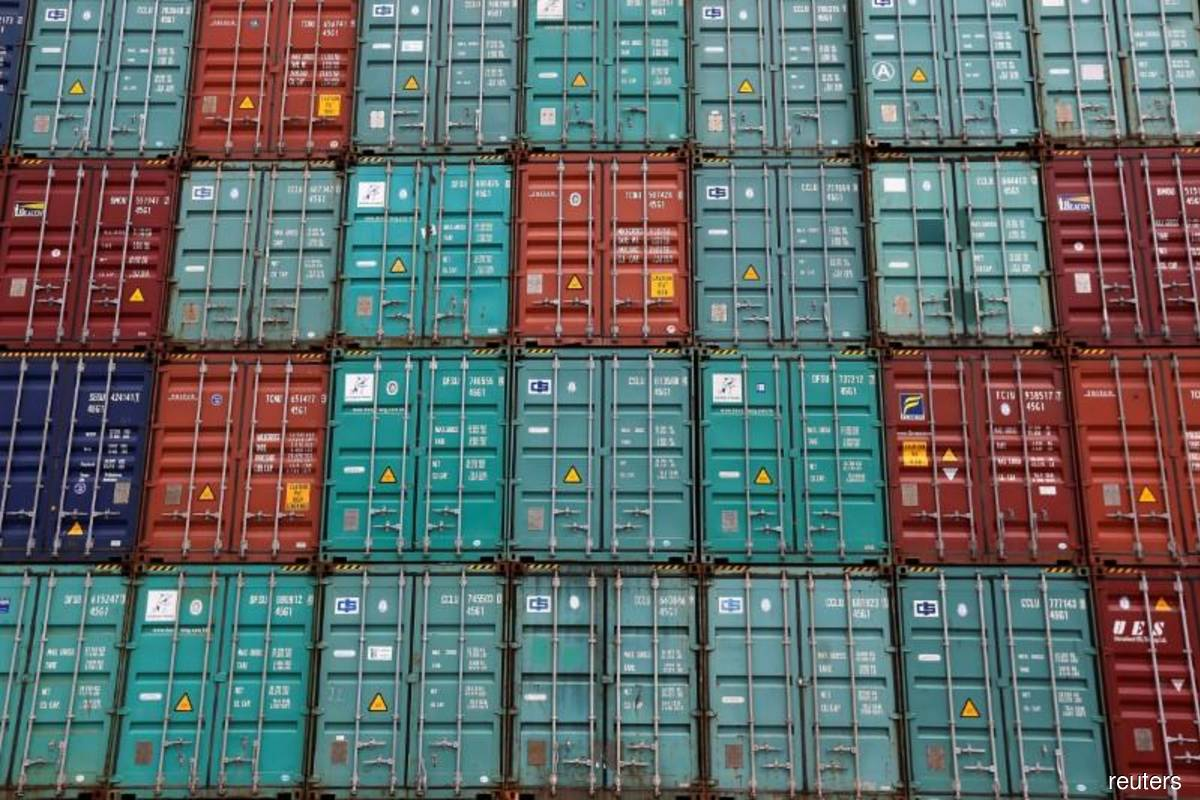M'sia sees slowest export growth in 15 months in October amid soft global demand
 Malaysia’s October exports expanded at the slowest rate in 15 months, growing 15% year-on-year (y-o-y) to RM131.6 billion, driven by increases in domestic exports and re-exports.
Malaysia’s October exports expanded at the slowest rate in 15 months, growing 15% year-on-year (y-o-y) to RM131.6 billion, driven by increases in domestic exports and re-exports.
受国内出口和再出口增长的推动,马来西亚 10 月出口增速为 15 个月以来最低,同比增长 15% 至 1316 亿令吉。
The export value was lower than the RM144.3 billion recorded in September.
出口值低于 9 月份的 1443 亿令吉。
Meanwhile, October imports increased 29.2% y-o-y to RM113.5 billion. This brought total trade in the month to RM245.2 billion.
与此同时,10 月进口同比增长 29.2% 至 1135 亿令吉。这使该月的总贸易额达到 2452 亿令吉。
As imports grew faster than exports, the trade surplus shrank to RM18.1 billion versus a record high of RM31.8 billion in September.
由于进口增长快于出口,贸易顺差从 9 月份的 318 亿令吉的历史高位缩减至 181 亿令吉。
Chief statistician Datuk Seri Dr Mohd Uzir Mahidin said in a statement that domestic exports totalled RM101.2 billion, which stood at 76.9% of total exports, and grew by 10.8% y-o-y.
首席统计师Datuk Seri Mohd Uzir Mahidin博士在一份声明中表示,国内出口总额为 1012 亿令吉,占出口总额的 76.9%,同比增长 10.8%。
“Meanwhile, re-exports were registered at RM30.4 billion (23.1% of total exports), widening by 31.6%.”
“与此同时,再出口额为 304 亿令吉(占总出口额的 23.1%),扩大了 31.6%。”
Uzir further explained that the rise in exports was due to higher exports to Singapore by RM4.1 billion, followed by South Korea (RM1.9 billion), and Japan (RM1.8 billion). Imports, on the other hand, were buoyed by increased imports from Saudi Arabia by RM5 billion, China (RM4 billion), and Taiwan (RM3.3 billion).
Uzir进一步解释说,出口增长是由于对新加坡的出口增加了 41 亿令吉,其次是韩国(19 亿令吉)和日本(18 亿令吉)。另一方面,沙特阿拉伯、中国(40 亿令吉)和台湾(33 亿令吉)的进口增加了 50 亿令吉,推动了进口。
In terms of exported products, Uzir said petroleum products increased by RM8.1 billion, followed by electrical and electronics products (E&E) (RM8 billion), liquefied natural gas (RM4.1 billion), and crude petroleum (RM1.5 billion).
在出口产品方面,Uzir表示,石油产品增加了 81 亿令吉,其次是电气和电子产品(E&E)(80 亿令吉)、液化天然气(41 亿令吉)和原油(15 亿令吉) .
Meanwhile, the rise in imports was attributed to increased imported crude petroleum by RM6.8 billion, followed by E&E products (RM5.6 billion), petroleum products (RM4.2 billion), and transport equipment (RM3.1 billion).
与此同时,进口增加归因于进口原油增加 68 亿令吉,其次是电子电气产品(56 亿令吉)、石油产品(42 亿令吉)和运输设备(31 亿令吉)。
UOB Global Economics & Markets Research noted that the recent external trade growth outturns in September and October suggest that Malaysia’s merchandise trade activity has entered a soft patch, in tandem with weakening global demand.
大华银行全球经济与市场研究部指出,最近 9 月和 10 月的对外贸易增长结果表明,随着全球需求疲软,马来西亚的商品贸易活动已进入疲软期。
“Volatile commodity prices and exchange rates were also factors weighing on the trade growth momentum amid a global tech down cycle. Moreover, other global leading indicators continued to point to rising recession risk going into 2023, sparked by prolonged Russia-Ukraine war, tighter global monetary and financial conditions, as well as China’s Covid zero policy,” the research house said in note on Nov 17.
“在全球科技下行周期中,大宗商品价格和汇率波动也是影响贸易增长势头的因素。此外,其他全球领先指标继续表明,进入 2023 年经济衰退的风险上升,这是由俄乌战争持续、全球货币和金融状况收紧以及中国的 Covid 零政策引发的,”该研究机构在11月17日报告中表示。
On the trade outlook, UOB said the fall in Malaysia’s manufacturing purchasing managers index from 49.1 in September to 48.7 in October implies further loss of momentum in manufacturing production, mainly due to subdued demand conditions, with the strongest moderation in new export orders since June 2021, which led firms to scale back output for the third month running and the most since March 2022.
在贸易前景方面,大华银行表示,大马制造业采购经理人指数从 9 月份的 49.1 下跌至 10 月份的 48.7,这意味着制造业生产进一步失去动力,这主要是由于需求低迷,新出口订单出现自 2021 年 6 月以来最强劲的放缓,这导致企业连续第三个月缩减产量,并且是自 2022 年 3 月以来的最大缩减。
“Accordingly, Malaysian manufacturers lowered input purchases for the second straight month and depleted stock levels, resulting in the fastest decline in post-production inventories in seven months. This was also reflected in the second month of growth slowdown in Malaysia’s imports of intermediate goods since September.”
“因此,马来西亚制造商连续第二个月减少投入采购并耗尽库存水平,导致生产后库存出现七个月来最快的下降。这也反映在自 9 月以来马来西亚中间产品进口增长放缓的第二个月。”
With that, it maintained its cautious stance on Malaysia’s exports, expecting a marginal gain of 1.5% in 2023, versus an estimated 26% expansion in 2022.
因此,它对马来西亚的出口保持谨慎态度,预计 2023 年边际增长 1.5%,而 2022 年估计增长 26%。
“The persistence of a high statistical base for two consecutive years in 2021 and 2022 is also expected to take a toll on the export growth momentum going into 2023. To counter this, the ratification of the Regional Comprehensive Economic Partnership (RCEP) and the Comprehensive and Progressive Agreement for Trans-Pacific Partnership (CPTPP), as well as the semiconductor supply chain resilience-linked memorandum of cooperation signed between the US and Malaysia, are anticipated to be key positive catalysts holding up Malaysia’s export growth prospects in the near term,” it opined.
“预计 2021 年和 2022 年连续两年高统计基数的持续存在也将对进入 2023 年的出口增长势头造成影响。为了应对这一情况,区域全面经济伙伴关系协定 (RCEP) 和全面经济伙伴关系协定的批准和跨太平洋伙伴关系进步协议(CPTPP),以及美国和马来西亚签署的与半导体供应链弹性相关的合作备忘录,预计将成为短期内支撑马来西亚出口增长前景的关键积极催化剂, ”它认为。
MIDF Research, meanwhile, expects more moderate growth rates for both exports and imports in the remaining months of 2022, as the low-base effect diminishes.
与此同时,MIDF Research 预计,随着低基数效应的减弱,2022 年剩余月份的进出口增长率将更加温和。
Having said that, the research house maintained its growth projections for exports at 26% and imports at 30.5%.
话虽如此,该研究机构维持其出口增长预测为 26%,进口增长预测为 30.5%。
“Based on the latest data, external demand remained robust despite concerns over slowing global growth.”
“根据最新数据,尽管担心全球增长放缓,但外部需求依然强劲。”
MIDF added that the trade sector stands to benefit from elevated commodity prices, growing external demand for E&E and commodities (petroleum and palm oil), and continued rise in global production and international trade activities. Imports will also expand further on the back of growing domestic demand, and increased business activities and consumer spending.
MIDF 补充说,贸易部门将受益于商品价格上涨、对电子电气和商品(石油和棕榈油)的外部需求不断增长,以及全球生产和国际贸易活动的持续增长。在国内需求增长、商业活动和消费者支出增加的支持下,进口也将进一步扩大。
